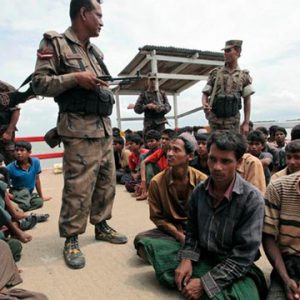With the region’s Rohingya migrant problem still unresolved, Southeast Asia Globe talked to Siegfried Wolf, a leading academic expert on the region, about the responses to the situation and what Asean and individual countries concerned can do
What’s your reaction to Wunna Maung Lwin’s [Myanmar’s minister of foreign affairs] statement saying that the migrant problem was a regional one linked to human trafficking and not due to persecution of Royhinga?
Wunna Maung Lwine is emphasising the government’s traditional line of argument that claims the Rohingya crisis is a matter of “mixed migration’, meaning that they are originally Bengalis (originating from Bangladesh) and entered Myanmar as economic refugees. However, due to a changed economic and social-political context they are now migrating back to their places of origin. Furthermore, he puts the Rohingya crisis in a security dimension. Here, the Rohingya are perceived as a security problem, meaning that the Rohingya themselves as a group constitute a security threat for Bangladesh’s state and society.
In other words, the confused and complex situation of Rohingya refugees in host countries is not only the logical consequence of the dramatic security conditions in Myanmar, but also perceived as the cause for conflicts in the host country with remarkable transnational spill-over effects. The latter has impacts in different domestic spheres of public life, especially with social, economic, environmental political and military aspects. Furthermore, the Rohingya are also increasingly classified as a burden to relations between countries in the region. However, through the lens of security it became clear that there is an increasing trend among analysts in Bangladesh and beyond to perceive the Rohingya issue not only solely as a humanitarian and refugee issue. Rather they identify the refugees increasingly as a so-called ‘non-traditional security threat’.
Do you think there’s a regional solution to this crisis? Or could the UN step in as it did with the Vietnamese boat people?
Unfortunately the UN have only limited opportunities to influence Myanmar to change its anti-Rohingya policies. However, the Rohingya issue can be only solved within Myanmar’s border. The UN and other international actors might be able to help to reduce and soften the negative impacts of the humanitarian crisis of the Rohingya stranded at sea or in camps. But the core of the problem is deeply entrenched within Myanmar’s Buddhist state and society. Only some substantial political reforms in Myanmar will promote a solution to the crisis. This includes a substantial reform of the country’s electoral system as well as the incorporation of legal procedures to protect the country ethnic and religious minorities.
At the moment, Myanmar’s political arena is marked by a phenomenon which is called ‘ethnic outbidding’. Basically interreligious relations are very complex in Myanmar. Muslims, especially the Rohingya, are confronted with a deeply-entrenched Islamophobia in a predominantly Buddhist society and state. The fundamentalists claim that the country’s Buddhist culture and society are under siege by Muslims, even more so when Myanmar is surrounded by many Islamic countries, like Bangladesh, Malaysia and Indonesia. The Rohingya are seen as a threat to the Buddhist lifestyle and faith as well as a gateway to Myanmar’s Islamisation. By having said this, it is likely that mainstream political parties will try to outbid each another by playing on the insecurities of different ethnic communities. The electoral rhetoric and strategies will be determined by a support for a rigid and populist anti-Muslim attitude and a systematic marginalization of the Rohingya minority. As a result, the polls will likely bring to power a central government that will continue the policy of excluding Rohingya from social and political life as well as from the distribution of national resources.
All this would force more Rohingyas to flee the country. In short, a domestic solution to the Rohingya problem would only be possible if Myanmar’s ruling elite and decision-makers change their mindset. But the struggle over the state’s resources, benefits from development projects and the exponential rise of Buddhist fundamentalism might not allow that change to happen. Last but not least, Myanmar’s government should take some lessons from South Asia into consideration. The fact, that Pakistan’s Taliban are calling for jihad against Myanmar government should be understood as a weak-up call that the ‘global jihad’ has arrived in Southeast Asia too.
What do you think of Asean’s response, so far? What could Asean do?
Most important is that the actors involved understand that an extended regional framework is needed to deal with the complexity of the Rohingya crisis. In this direction, Asean offers an excellent platform to bundle efforts in Southeast Asia. But its effectiveness regarding the solution to the ongoing Rohingya crisis will be limited because of following factors: The respective Asean countries are affected differently by the crisis. Subsequently, there will be only limited political will and interest among several member states to solve the issue via procedures or mechanisms offered by Asean. Additionally, any solution regarding the consequences and courses of the Rohingya crisis will have a remarkable impact on national sovereignty. This determines a factor that is not in line with the original founding spirit of Asean, which focuses on the promotion of economic cooperation and development. However, theoretically the new Asean Charter of 2007 would allow Asean countries to interfere in the affairs of other member states in a vocal manner, despite the 1976 Treaty of Amity and Cooperation. But in practical terms, the new charter does not sufficiently equip Asean to deal with controversial issues and certainly does not offer anything new that could help to convince Myanmar to change its ‘Rohingya policy’.
It is important to stress that, unlike the European Union, Asean is not a political project of unifying a regional entity including more or less all spheres of state and society. Furthermore, there is an imminent threat that bilateral conflicts (like Thailand-Cambodia) and asymmetries regarding power and geographical location between Asean member states might hamper the decision-making process of the body. One only has to look at the tense India-Pakistan relations, paralysing more or less completely any substantial regional cooperation via the South Asian Association for Regional Cooperation. These phenomena could have severe negative ramifications for a sustainable solution for the Rohingya crisis. However, Asean could become important, especially on the sub-regional level in order to promote transnational cooperation.

The fact, that the latest conference in Bangkok gained a significant boost from the successful bilateral talks between Malaysia and Indonesia on how to deal with the current Rohingya problem, can be seen as an indication of this. Nevertheless, in order to find a comprehensive and sustainable solution for the crisis including consequences as well as courses, South Asian states must be included too. Therefore, a new regional organisation or regime would be needed which serves as a platform for dialogue between South Asia and Southeast Asia, including not only cultural and economic but political and security dimensions too. The development of a transnational coherent refugee policy, which is actually hard to find anywhere in Asia (or even in Europe), could serve as a point of reference for new regional collaboration. It could be something like an Organisation for Security and Co-operation in Europe for Southern Asia based on a closer cooperation between the areas of South and Southeast Asia (and beyond). However, it is essential that such an institution is understood as an instrument to strengthen the existing organisations of ASEAN and SAARC and not to substitute them.
To conclude, regional governments in South and Southeast Asia must identify the unsolved Rohingya problem as a chance for constructive regional cooperation instead of a roadblock for further collaboration. It seems that the actors involved understand that a regional framework is needed to deal with the complexity of the Rohingya crisis. Therefore, the conference marked a significant step towards the institutionalisation of mechanism in order to deal not only with the problems of the current humanitarian crisis of the migrants but could also serve as a roadmap for future challenges.
What’s your reaction to the recent conference in Bangkok? Did it achieve anything?
In short, there was no major breakthrough. However, besides all the hurdles and criticism, one can state that the Bangkok conference was a crucial step in the right direction accomplishing several noteworthy ‘promises’ by the participating countries.
Firstly, the meeting got states of South and Southeast Asia talking with each other about the issue of the Rohingya. This is an achievement in itself, as major cooperation between these two Asian sub-regions has not taken place yet.
Secondly, it was the first time that the participating states exchanged their views in a comprehensive manner on how to tackle the Rohingya crisis and to being able to find at least a common proposal on how to implement immediate action. Thus, despite the fact that no date was set for the next round of talks, it was significant that the participating countries agreed to continue dialogue.
Thirdly, the conference received pledges from donor countries for money, especially the US, Australia, and Japan. It is envisaged the money will be used to pay for temporary shelter, food and other urgent needs for the refugees as well as for humanitarian aid for needy people in Myanmar’s Rakhine state and Bangladesh’s Cox’s Bazaar district. Nevertheless, the amount financial aid is far away from being sufficient. For example, the International Organization for Migration appealed for $26 Million. Fourthly, besides several other measures, the enhancement of maritime search and rescue missions to help refugees who are vulnerable “boat people” stranded in the region’s seas marks an extraordinary step for immediate help. Finally, one has to state that the conference only dealt with the consequences but not with the root causes.
Do you see any willingness from Myanmar’s government to resolve this problem internationally?
Basically one can state that the Bangkok conference was characterised by a complex balancing act of proposing concrete measures to deal seriously with the crisis of the Rohingya while attempting to appease Myanmar. The latter was declared by many conference participants as the most important since any open ‘finger pointing’ would lead to a boycott or ‘un-cooperative’ behaviour of Myanmar’s delegates. Despite the fact that the participation of a Myanmar delegation is essential to deal with the consequences of the crisis, there was no indication at all that Myanmar offered any hint of willingness to address the roots of the problem. Initiatives to move forward would be to grant Rohingya full citizenship, stopping government-supported religious fundamentalism and anti-Muslim sentiments as well as the establishment fair resource allocation. Also there is no measure to stop social and political exclusion of Rohingya in general. The fact that Myanmar authorities describe the outcome of the Bangkok conference as a non-committal proposal speaks for itself.
Siegfried O. Wolf is a director of research at the Brussels-based South Asia Democratic Forum as well as a researcher at the University of Heidelberg’s South Asia Institute.


